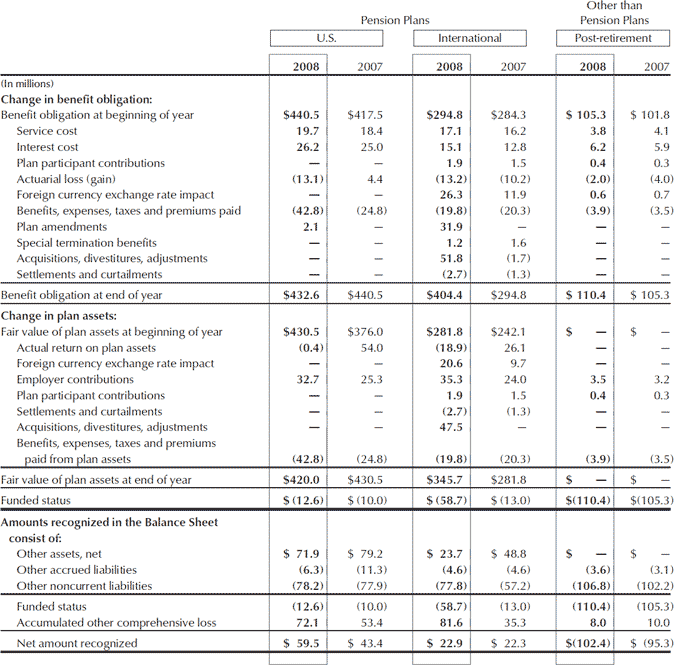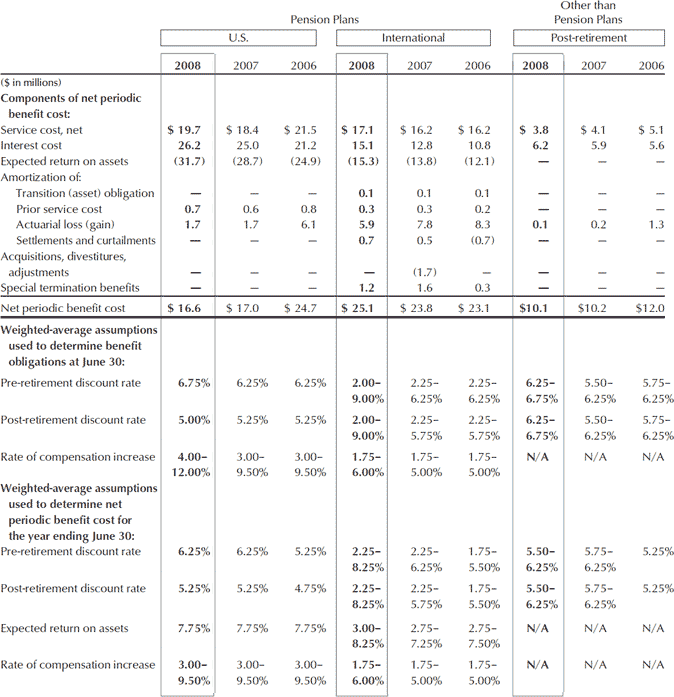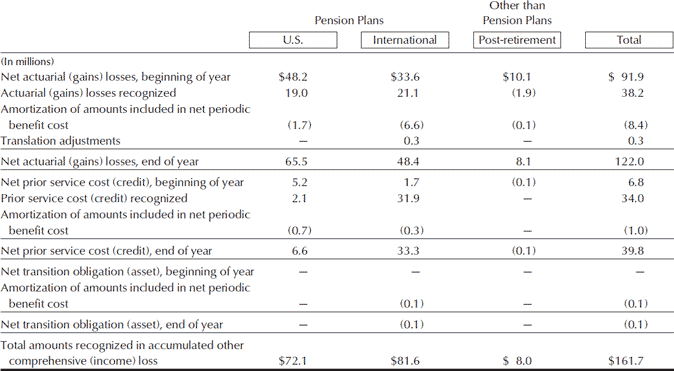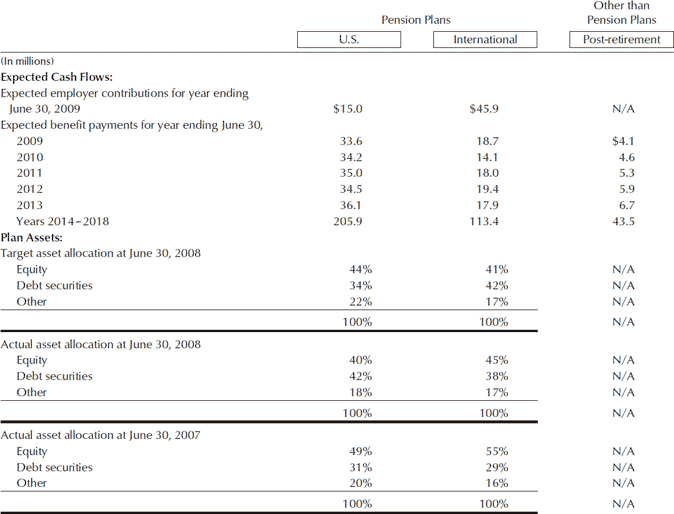|
NOTE 13-PENSION, DEFERRED COMPENSATION AND POST-RETIREMENT BENEFIT PLANS
The Company maintains pension plans covering substantially all of its full-time employees for its U.S. operations and a majority of its international operations. Several plans provide pension benefits based primarily on years of service and employees' earnings. In certain instances, the Company adjusts benefits in connection with international employee transfers.
Retirement Growth Account Plan (U.S.)
The Retirement Growth Account Plan is a trust-based, noncontributory qualified defined benefit pension plan. The Company's funding policy consists of an annual contribution at a rate that provides for future plan benefits and maintains appropriate funded percentages. Such contribution is not less than the minimum required by the Employee Retirement Income Security Act of 1974, as amended, ("ERISA") and subsequent pension legislation and is not more than the maximum amount deductible for income tax purposes.
Restoration Plan (U.S.)
The Company also has an unfunded, non-qualified domestic noncontributory pension Restoration Plan to provide benefits in excess of Internal Revenue Code limitations.
International Pension Plans
The Company maintains International Pension Plans, the most significant of which are defined benefit pension plans. The Company's funding policies for these plans are determined by local laws and regulations. The Company's most significant defined benefit pension obligations are included in the plan summaries below. Fiscal 2008 plan data reflects a plan amendment designed to provide certain employees of a particular affiliate an opportunity to participate in a defined benefit pension plan with enhanced benefits as compared with their current defined contribution plan. In addition, fiscal 2008 plan data reflects the growth and relative significance of certain other defined benefit plans.
Post-retirement Benefits
The Company maintains a domestic post-retirement benefit plan which provides certain medical and dental benefits to eligible employees. Employees hired after January 1, 2002 are not eligible for retiree medical benefits when they retire. Certain retired employees who are receiving monthly pension benefits are eligible for participation in the plan. Contributions required and benefits received by retirees and eligible family members are dependent on the age of the retiree. It is the Company's practice to fund these benefits as incurred.
Certain of the Company's international subsidiaries and affiliates have post-retirement plans, although most participants are covered by government-sponsored or administered programs.
Plan Summaries
In September 2006, the FASB issued SFAS No. 158, "Employers' Accounting for Defined Benefit Pension and Other Postretirement Plans-an amendment of FASB Statements No. 87, 106, and 132(R)" ("SFAS No. 158"). SFAS No. 158 requires employers to recognize a net liability or asset and an offsetting adjustment to accumulated other comprehensive income to report the funded status of defined benefit pension and other post-retirement benefit plans. Previous standards required employers to disclose the complete funded status of its plans only in the notes to the consolidated financial statements. Changes in the funded status of these plans will be recognized as they occur through other comprehensive income. Additional minimum liability adjustments are no longer recognized upon adoption of SFAS No. 158. As of June 30, 2007, the Company prospectively adopted the balance sheet recognition provisions of SFAS No. 158, which resulted in a net adjustment of $57.3 million (after tax) to reduce accumulated other comprehensive income.
The significant components of the above mentioned plans as of and for the years ended June 30 are summarized
as follows:


The pre-retirement discount rate for each plan used for determining future net periodic benefit cost is based on a review of highly rated long-term bonds. The pre-retirement rate for the Company's U.S. Plans is based on a bond portfolio that includes only long-term bonds with an Aa rating, or equivalent, from a major rating agency. The Company believes the timing and amount of cash flows related to the bonds included in this portfolio is expected to match the estimated defined benefit payment streams of its U.S. Plans. In determining the long-term rate of return for a plan, the Company considers the historical rates of return, the nature of the plan's investments and an expectation for the plan's investment strategies.
Assumed health care cost trend rates have a significant effect on the amounts reported for the health care plans. The assumed weighted-average health care cost trend rate for the coming year is 9.34% while the ultimate trend rate of 5.00% is expected to be reached in fiscal 2016. A one-percentage-point change in assumed health care cost trend rates for fiscal 2008 would have had the following effects:

Amounts recognized in accumulated other comprehensive (income) loss (before tax) as of June 30, 2008 are
as follows:

Amounts in accumulated other comprehensive (income) loss expected to be amortized as components of net periodic benefit cost during fiscal 2009 are as follows:

The projected benefit obligation, accumulated benefit obligation and fair value of plan assets for the Company's pension plans at June 30 are as follows:

International pension plans with projected benefit obligations in excess of the plans' assets had aggregate projected benefit obligations of $298.6 million and $115.4 million and aggregate fair value of plan assets of $216.2 million and $53.6 million at June 30, 2008 and 2007, respectively. International pension plans with accumulated benefit obligations in excess of the plans' assets had aggregate accumulated benefit obligations of $95.2 million and $81.2 million and aggregate fair value of plan assets of $41.4 million and $35.3 million at June 30, 2008 and 2007, respectively.

The target asset allocation policy was set to maximize returns with consideration to the long-term nature of the obligations and maintaining a lower level of overall volatility through the allocation to fixed income. During the year, the asset allocation is reviewed for adherence
to the target policy and is rebalanced periodically towards the target weights.
401(k) Savings Plan (U.S.)
The Company's 401(k) Savings Plan ("Savings Plan") is a contributory defined contribution plan covering substantially all regular U.S. employees who have completed the hours and service requirements, as defined by the plan document. Regular full-time employees are eligible to participate in the Savings Plan thirty days following their date of hire. The Savings Plan is subject to the applicable provisions of ERISA. The Company matches a portion of the participant's contributions after one year of service under a predetermined formula based on the participant's contribution level. The Company's contributions were approximately $18.7 million, $13.7 million and $10.6 million for the fiscal years ended June 30, 2008, 2007 and 2006, respectively. Shares of the Company's Class A Common Stock are not an investment option in the Savings Plan and the Company does not use such shares to match participants' contributions.
Deferred Compensation
The Company accrues for deferred compensation and interest thereon, and for the increase in the value of share units pursuant to agreements with certain key executives and outside directors. The amounts included in the accompanying consolidated balance sheets under these plans were $67.9 million and $69.6 million as of June 30, 2008 and 2007. The expense for fiscal 2008, 2007 and 2006 was $9.2 million, $8.5 million and $11.6 million, respectively.
|